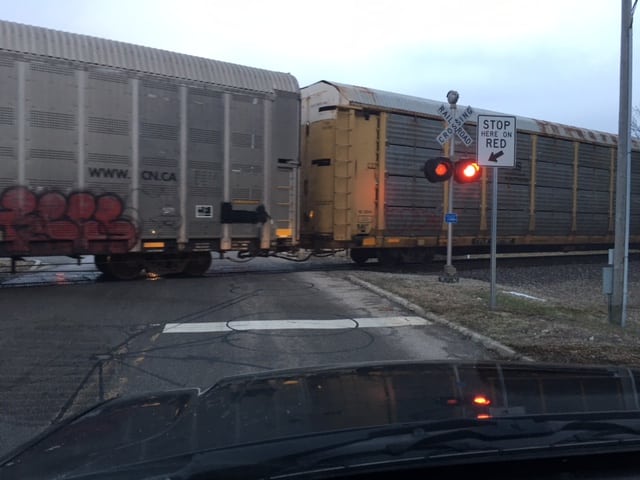COLUMBUS, Ind. — Columbus is still looking to reduce noise from trains, but there’s a lot of work left to be done before that could become a reality.
The Columbus Redevelopment Commission is entering in a contract with Alfred Benesch and Co. to assist in administrative details to create a “quiet zone” in Columbus. Redevelopment director Heather Pope said the contract amount is not to exceed $15,732.
It is not guaranteed that the city will decide to create a quiet zone, she said.
The proposed quiet zone would include crossings at Fifth Street, Eighth Street, 11th Street and the State Road 46 pedestrian crossing. Safeguards would include enhanced gates, as well as medians that prevent vehicles from driving around a gate.
Train engineers who are coming through Columbus are sounding their horns four times, as state law requires, at each of the four crossings within the city limits. That’s 16 times per train as they pass four intersections: State Roads 46 and 11, and at Fifth, Eighth and 11th Streets.
About 13 trains routinely travel along this railroad line daily, sounding their horn for each public crossing as required by law. A study commissioned by the city indicates it could have as many as 22 trains a day in the future as L&I, which has leased the tracks to CSX, increases traffic on the line this year.
Under federal regulations, trains must sound their horns as they approach public grade crossings “in a standardized pattern of two long, one short and one long blasts.” The pattern must be “repeated or prolonged” until the leading car or locomotive occupies the crossing.
However, the Federal Railroad Administration allows cities to create quiet zones to lessen the noise, provided that certain requirements have been met.
In a “quiet zone,” railroads have been directed to cease the routine sounding their horns when approaching public highway-rail grade crossings. Trains may still sound their horns in certain circumstances, including if there is an emergency or if it is required by another federal regulation or railroad operating rule. To establish a quiet zone, a city must first implement measures to “mitigate the increased risk caused by the absence of a horn,” according to federal regulations.
Originally, CTC, Inc. was the city’s consultant in exploring the possibility of a quiet zone. However, CTC underwent a reorganization and its functions were absorbed by two other companies.
Kurt Anderson, who was part of the original CTC team that worked with the city, explained that the company’s engineering functions largely became part of Alfred Benesch and Company, a civil engineering firm with headquarters in Chicago.
“The whole team that was at CTC doing quiet zones is now within our group at Alfred Benesch,” Anderson said. “So it’s the same people.”
“They (CTC) did half of the work, and we paid a portion of their fee, but they had a remaining balance. And CTC’s no longer in existence,” Pope said.
Assistant city engineer Andrew Beckort reminded the commission that in 2019, it voted to move forward with Louisville and Indiana Railroad (L&I) on a design agreement for work on engineering estimates. That agreement has finally been signed, he said.
Alfred Benesch and Co. would continue the work that began at CTC, Anderson said. Previously, the company did an evaluation of both the possibility of a quiet zone and its alternatives, as well as the costs of different scenarios.
Now that the preliminary engineering agreement has been signed, the railroad will prepare estimates on the work identified in the evaluation study, Anderson said. While the CTC team had shared some cost estimates in the past, these were more “ballpark” figures.
After the estimates are in, he said, the city would need to enter into a construction and maintenance agreement with the railroad.
“All of that takes time,” he said. “… And then once that’s done, there’s some long lead times associated with the signal equipment that needs to be installed. And that can be a year, possibly, before the construction’s complete. So we’re probably looking at — just a rough estimate — somewhere between a year and a year and a half to get to the point where the construction’s complete.”
Anderson said that while some of the firm’s work will take place now, other parts of it may not occur for over a year. As the project moves into its “implementation phase,” the company’s work would potentially include:
Reviewing documents, including the railroad’s cost estimates
Preparing a notice of intent to create the quiet zone and assisting the city with its submission
Reviewing construction plans
Coordinating with the railroad and the federal government as needed
The company has also proposed visiting upon the project’s completion and checking to ensure that the implemented improvements are compliant with both the design and quiet zone requirements. This would be prior to issuing the notice of establishment for the quiet zone, he said.





